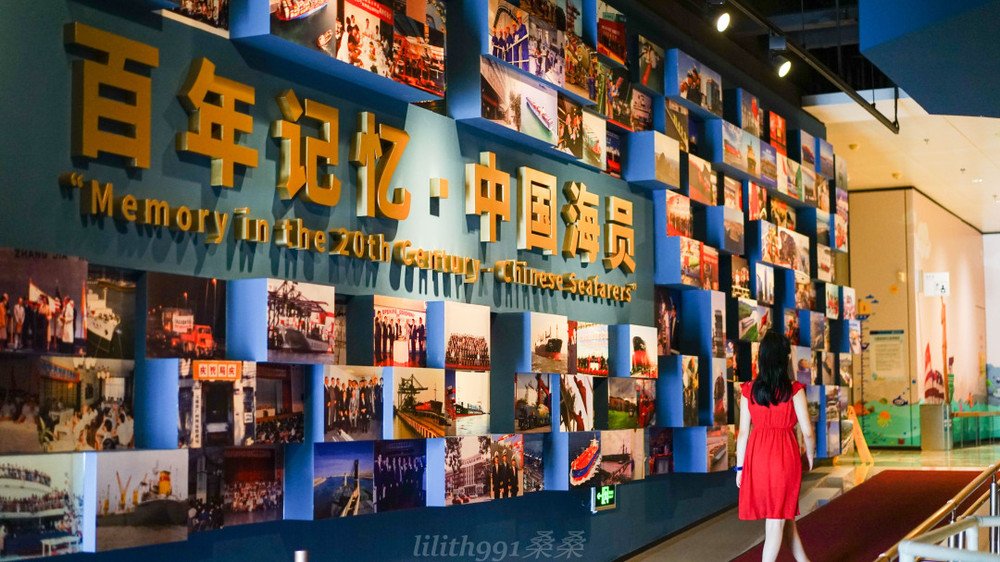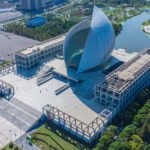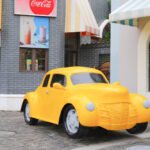Duration: 1 day. Time: July. Per capita cost: 100 yuan. With whom: Parent-child. Play styles: Humanities, independent travel, weekend tour. The author visited these places: China Maritime Museum, Dishui Lake, Donghai Bridge, Shanghai Huangpu River, Paramount. Posted on July 14, 2020, 19:19. The Age of Great Navigation was once the best era and an important part that cannot be ignored in the brief history of humanity. That era is also the one I yearn for. Interestingly, the work of my family members is more or less related to navigation. So, a visit to the China Maritime Museum is a must. This is an indissoluble fate. Transportation: Bus routes include Longgang Express Line (at Huanshanxi 3rd Road and Shengang Avenue Station), Sangang Special Line (at Huanshanxi 3rd Road and Shengang Avenue Station), Shengang Route 1 (at Huanshanxi 2nd Road and Shengang Avenue Station), and Shengang Route 3 (at Huanshanxi 3rd Road and Shengang Avenue Station). Subway route: Take Metro Line 16 and get off at Dishui Lake Station. Then take the inner loop of Shengang Route 1 (take 2 stops) and get off at Huanshanxi 2nd Road and Shengang Avenue Station. Self-driving route: Outer Ring Road S20 (towards Pudong Airport) → transfer to S2 Expressway (towards Donghai Bridge) → Exit at Dishui Lake to the China Maritime Museum. The parking lot is relatively large, so self-driving is recommended. Opening hours: 9:30 – 16:00. Admission stops at 15:30. Closed on Mondays, except holidays. In addition, due to the recent special situation, reservations are required and there is a limit on the number of people. Remember to make an appointment in advance on the Shanghai Tourism Code. Tickets: There are discounts recently. Adults are 30 yuan; college, high school, and primary school students with student ID cards are 15 yuan; seniors aged 60 – 69 with valid certificates are 10 yuan. There are also quite a number of free admissions. Especially there are free activities for seafarers, which is quite rare among museums. In this plum rain season, sometimes I feel that I am not in Shanghai but on the sea. It’s a bit damp. Finding a day to go out without rain is really a miraculous existence. But on that day when I went to the Maritime Museum, I was so lucky that it didn’t rain and the weather was good. The float of Shanghai in the 70th anniversary military parade can also be seen here. You can take the elevator up these steps or walk up. It seems like walking on the nautical road that predecessors walked. Suggested visiting order: Ming Dynasty Fuchuan – Maritime History Museum – Seafarers Museum – Ship Museum – Temporary Exhibition Hall – Waterside Platform Activities – Maritime and Port Museum – Maritime Affairs Museum and Maritime Safety Museum – Military Maritime Museum – Cultural and Creative Center. The Ming Dynasty Fuchuan. Actually, entering is on the second floor. You can directly see the exterior of the Ming Dynasty Fuchuan. However, this Fuchuan is very large in area. So if you want to see the whole picture, you need to look carefully layer by layer. And you can board the ship. Recently, only 10 people are allowed on board each time.
This is a popular exhibit here, and many children visit the Maritime Museum during the summer vacation specifically for this ship. It is a 1:1 scale replica of a giant Ming Dynasty sailing ship, capable of sailing on water, which takes us back to the age of sails, the era when Emperor Zhu Di of Ming Dynasty supported Zheng He’s voyages to the Western Seas, a time of glory for feudal China. Although we missed the Age of Discovery, we have our own traditions and culture. The Maritime History Hall (highlight) is a place where one might spend a considerable amount of time if looking for a guide. It tells the story of the history of navigation, from rafts and dugout canoes to sails and mechanization. Here, you will find the museum’s most ‘valuable’ Spring and Autumn period warship, which is one of the treasures of the museum. Its high value is not only due to the fact that the ship is made entirely of pure gold, but also because of its intricate details, such as the soldiers, rowers, and even the bows and arrows used in battles on the two-tiered warship, all clearly discernible. This craftsmanship spirit is evident here. This place is really suitable for children to visit, especially older children, as they have begun to understand history and are willing to open their eyes to the world. My daughter stood in front of the giant rudder, feeling the size of it, and thus could understand how huge the ship was back then. There is also the ‘Daming Hunyi Map’, which is the largest, oldest, and best-preserved colored world map drawn by Chinese people that we know of to date. It is also the earliest world map that depicts Africa. Different periods of sails and models of ships from different periods and regions. The Yidun ship, with exhibits accompanied by introductions, can be closely observed. There is also the Jiaolong submersible. In the Mariners’ Hall, there was once a family member who was an ocean-going sailor, responsible for radio and GPS, so he was quite familiar with ships and navigation. The most interesting thing in the Mariners’ Hall is the navigation simulator, where you can put on 3D polarized glasses and walk into a virtual ship’s cockpit. Recently, up to 5 people can enter at a time, and the Huangpu River channel and the World Expo park are vividly presented. There are also various introductions about sailors, even the display of sailors’ cabins, very interesting, this display is already the captain’s room, lower-ranking sailors such as sailors and mechanics are generally in bunk beds, several people in one room, and not so wide a bed, generally around 70CM, especially for tugs, ocean-going cargo ships can be larger. Walking with the child through this wall, it’s as if we have traveled through a century of maritime history. The Ship Hall mainly displays the structure and equipment of modern ships and shipbuilding techniques from different eras, with some ships having cross-sections, bows, overall, and engine introductions, from ancient times to the present, as well as different types of propellers.

Here, you can marvel at the inner workings of the submarine 033, a truly fascinating experience. Try your hand at being a helmsman and explore the various gauges and instruments on board to understand their functions. To thoroughly examine and enjoy all the exhibits, allocating four hours is essential. The Maritime and Port Pavilions, including the Maritime Museum and the Maritime Safety Pavilion, offer varying degrees of knowledge about navigation and ports. The Maritime and Port Pavilion is located on the second floor of the museum, showcasing the marine environment and various instruments and technologies that ensure the safe navigation of ships. From ancient celestial navigation devices to modern sextants, octants, and advanced systems like radio and GPS, these navigational instruments have been used from ancient times to the present day. For those who love the navy, like myself, the Military Navigation Pavilion is a favorite. It features two main exhibition areas: the construction of the People’s Liberation Army Navy and knowledge about warships, displaying numerous artifacts reflecting significant historical events of the Chinese Navy. There are various models of warships, including the Musashi, the sister ship of the largest battleship Yamato, which was sunk before leaving the port. The sight of various military flags flying is quite spectacular. Additionally, there are models like the ‘Anshan’ destroyer, ‘Jinan’ missile destroyer, and the ‘Ohio’ class missile nuclear submarine… The Maritime and Maritime Safety Pavilion is composed of two main exhibition areas. In terms of temporary exhibitions, the recent ‘Jinghai Divine Machine’ focuses on firearms and is worth visiting again. When I visited, there was a joint exhibition by the China Maritime Museum, Shanghai Municipal Oceanic Administration Center, and Shanghai Municipal Archives, titled ‘Ports for the City, Cities Prosper by Ports: The Integration of Modern Shanghai City and the Ocean.’ The exhibition is divided into three parts: ‘River and Sea Transportation,’ ‘Shipping Hub,’ and ‘Pioneering Spirit,’ showcasing nearly a hundred artifacts, documents, and models from various dimensions such as ‘shipping, economy, culture, urban construction, and citizen life’ to illustrate the profound impact of the ocean and navigation on the city of Shanghai. There is also a model of the Shanghai emblem and a sandship, which not only allows you to learn about Shanghai’s history but is also a great place for photography. With the ambiance of the Shanghai style, you can see cheongsams and rickshaws, which seem to take you back to the bustling Shanghai of a century ago. There are also iconic Shanghai buildings like the Paramount, where you can stand on the stage and leave your beautiful silhouette. Don’t forget to leave your name on the blackboard when you leave, as a testament to the changes in Shanghai. Of course, it’s not just about watching here; you can also participate and have fun. For example, on the first floor’s waterside platform, you can encounter the Maritime Life Festival. The main stage of the Maritime Life Festival features performances such as ‘Flag Signaling Performance,’ ‘Sailor Knot Interaction,’ and ‘Maritime Children’s Drama.’ There are various games for both children and adults, and I highly recommend the ‘VR Rowing Challenge,’ ‘Remote Control Boat Experience,’ ‘Building Giant Paper Boats,’ ‘Maritime Bottle Throwing Ceremony,’ ‘Maritime Maze,’ and ‘Maritime Mini Triathlon.’ My child absolutely loves the remote control boats and bottle throwing, and they can’t stop playing.
Don’t forget to stamp your card for a chance to receive gifts. If you complete all the activities, you might even win a model set of the Liaoning aircraft carrier! I’m envious of that. There’s also a model of the Liaoning ship right next to it. The museum includes a café and dining area, so you can enjoy meals within the premises. Before leaving, make sure to visit the cultural and creative center. The cultural products here are distinctive and largely ocean-themed, such as the nautical chart series, Chao Zong Yu Hai tapestry, notebooks, and Zheng He series pen holders, all of which are incredibly interesting and have captured my heart. There are also brass magnifying glasses and three-section telescopes, filled with an antique charm, which I decided to take home without hesitation. The China Maritime Museum is truly a treasure trove of a museum. My daughter’s classmates only learned about our visit after we returned, expressing regret for not joining us. We plan to come back for a special exhibition, combining education with entertainment.






